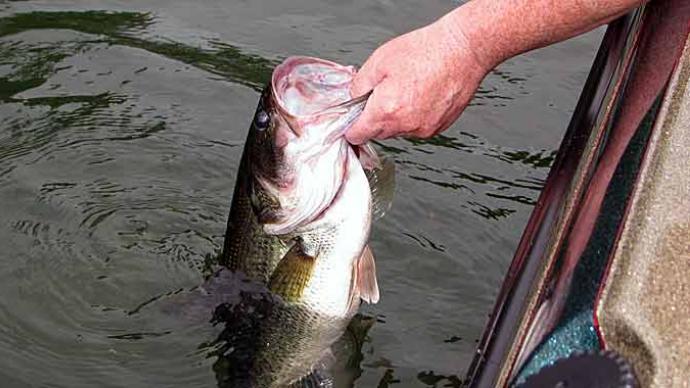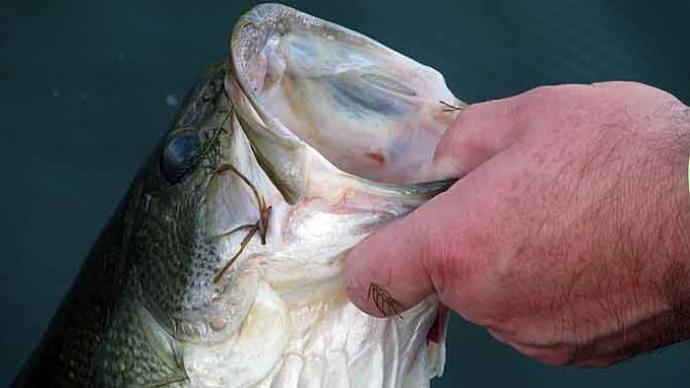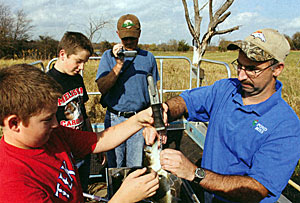
In largemouth bass/bluegill populations, there are only four "natural" situations and, unmanaged, over time, they lead mostly to one...bass overcrowding. Here are the four: "Balanced"...a situation where there is a variety of size classes of the different species, all in good body condition. The second, and most common, is "Bass crowded". That's where, you guessed it, bass have overeaten the food chain and have stopped growing. Most of the time, the bass are one size class, maybe 9 to 12 inches and as much as 40% underweight. In these cases, bluegills are giant, trophies in their own right, but the bass are anything but braggin' size. The third scenario, most common north of the Mason-Dixon Line, is "Bluegill crowded". In this case too many bluegill dominate the underwater landscape, completely disrupting largemouth bass reproduction and recruitment. Bass are few and far between, but usually nice and fat. Bluegills in these situations are under¬achieves, often smaller than 6 inches. The fourth situation is "Everything else". Where might you see that? It's a fish population in transition, trying to figure out which of the above three it wants to be. For example, there's a drought. The pond drops six feet over two years. Fish are confined to one-fourth the area and one-eighth the volume of water. Over that span of time, fish adjust. Big fish eat small ones and their numbers drop, overall, to the size water in which they live. Then, rains come and the pond refills. Now, you have less than one-fourth the crop of fish this "new" water can support. Guess what happens? Your fish reproduce and fill these new niches. That's a transitional state. Another one is post-flood. Another is how a pond might respond after a partial fish kill.. .due to hot, overly-fertile water in summer or winterkill in the cold months. The following two to three years in each of these cases is spent recovering to become one of the other three situations.
For you, let's say you recently bought a piece of property with two pretty lakes. As a matter of fact, let me introduce you to Dennis Rodgers, from Melissa, Texas. He's traveling a path not unlike many a pondmeister before him. Dennis and his wife, two teens and a pre-teen in the fam, along with his excited father-in-law, have been looking for a weekend place for several years. Finally, they found it, south of Ector, Texas, in the northern part of the state, not thirty minutes from home base. One of the criteria for the land? It had to have water...a place to fish and enjoy the benefits of surrounding nature. There, nestled in the Blackland Prairie, they found their paradise.
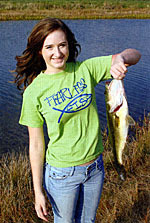
Yours truly electrofished the two lakes, each covering about five acres.
Lake one, the fishiest looker, was loaded with standing dead timber, mostly Bois d'arc. We fired up the generator, pushed the safety switch at the bow and motored toward the trees. In short order, we had gathered five size classes of bluegill and basically one size class of bass...mostly 12-15 inches, with two outstanding specimens pushing over 18 inches. Total bass taken in 30 minutes of electrofishing was 17, not a very large number. But, these fish looked like Jared before he went on his Subway diet... "stout" we might say. This lake had not been managed nor recently stocked. It wasn't balanced...or we would have seen more bass in different size classes. All the bluegill appeared to be quite young, no older than two years. Studying the bass, they had all the morphological characteristics of young bass, too. The oldest? Maybe three years old. The pond was built in 1983 and stocked shortly thereafter. Something wasn't right. This population wasn't bass heavy, nor was it overcrowded with bluegill. When we did the electrofishing survey, the realtor tagged along. The Rodgers family hadn't owned this place but two weeks and their realtor was just as interested about what was in this pond as his clients were. My conclusion? Fish kill... two, maybe three years ago. This fishery was responding to a stimulus. A fish kill made the most sense. I asked the realtor a few questions, hoping he knew about this property for some time. He said, "On GoogleEarth, you can see this lake. It's so green I noticed it." Fertile water, unmanaged, with cattle all over the pasture. It sure made sense.
We loaded and launched the boat into lake two, just downstream from this beauty. As soon as the juice hit the water, bass began popping up like popcorn. Bass, bass everywhere. We collected 40 bass in 20 minutes. That's a lot of fish. These fish looked like some of those runners in the Boston Marathon. Lean, mean machines. Much of the lake was covered with coontail, an invasive plant that knows no boundaries in fresh water. Inside the dense mats of aquatic greenery hid literally thousands of baby sunfish, mostly bluegills. The bass couldn't get to the cafe... and those morsels had little inclination to make a run beyond the borders. Bass were clearly overcrowded in this lake, a polar opposite situation compared to the lake to its south. These bass were more than 25% underweight. We weighed and measured 40 fish larger than 9 inches and every one of them except the four smallest ones, were definitively underweight.
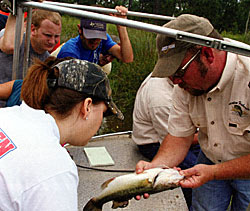
Dennis Rodgers now has a series of decisions to make.
Let's bring you into this discussion. You've weighed, measured and counted enough bass from your favorite fishing hole. You've looked at the relative weight charts and it's become clear that you have several size classes of bass that aren't growing at the pace you expect. Heck, some of the middle-sized bass are losing more weight than you thought, even though your feeder is doing yeoman's work pitching out high protein morsels faithfully.
The conclusion is clear. Your bass are overcrowded. What in the world should you do?
Like our good friend. Bill Cody, The Lake Doctor, says, "It all depends".
On what, you say?
On your goals.
If you want trophy bass...cull, cull, cull. Cull until the lake forces you to stop.
If your mission is to have a balanced fishery, harvest selectively.
If you want your kids to catch a fish every cast, leave it alone.
If trophy bass is truly the mission, your job is to protect the best, fastest growing females of the lot and diversify your food chain to accommodate the best fish. Trying to grow bass to 14 inches is job one. That's the easiest job. It's getting them beyond 16 inches that's tough. A 16 inch bass' mouth is large enough to eat a ten inch bass. That's when its life changes. Managing for trophy bass means selectively culling those bass which don't fit into the program and managing a food chain for a variety of foods, with bluegill being the backbone. But, this situation is one where you want threadfin shad, maybe tilapia in the proper circumstances and gizzard shad, if you know what you are doing. Cull small bass like crazy. When you catch a young fish with a big, fat belly, make it force you to let it go. If you have any doubt whether or not to take it out, leave it in. Don't be afraid to remove as many as 25-35 pounds of bass per surface acre per year, more if the remaining fish aren't responding with good growth.
If a balanced fishery is your goal and overcrowded bass are the issue, forget the gizzard shad, consider the threadfins, but be sure you plan to cull a variety of sizes of bass. In this case, give yourself permission to take bass from 10 inches all the way to 18 inches. Odds are you don't have many bass larger than 14 inches in an overcrowded bass pond, so be prepared to adjust your selective harvest plan as the bass population responds to your stimulus. Bass bigger than 18 inches should be released, as they help you cull the smaller bass by eating them, plus a bass larger than 18 inches has a legitimate shot to grow much, much larger.
So, that's it? Cull fish selectively, based on your goals?
Nope, that's just part of it.
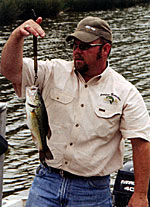
Remember, overcrowded bass got that way because they overate the food chain and weren't harvested when the time was right. The longer a lake sits in that overcrowded state, the tougher it is to fix it. It's almost like trying to unpickle a pickle. I can't tell you how many times over the years I've come across lakes that had one species of fish...bass...and the poor creatures looked like skeletons with green, scaly skin wrapped around weary old bones. Not a bluegill in sight. These lakes and ponds have been that way for too many years. Young fish don't stand much of a chance...they are quickly eaten as they come off the nest. Another situation, just as common, is lots of mostly underweight healthy bass, with a few adult bluegills reaching old age. In this case, we can assume the fishery has been that way for some time nearing five or six years.
While culling is the mainstay recommendation biologists are safe to offer, another smart move is to focus on the food chain. As you adjust numbers of bass, have plans to beef up your food chain. That might mean stocking additional adult bluegills. It might mean adding some dense habitat such as brush piles for safe hiding places for young bluegill. It might mean a feeding program targeted at forage fish. It might mean diversifying your food chain with redear sunfish or threadfin shad or another species which thrives in your part of the planet. It could mean fertilizing your water each spring to help increase survival rates of your baby fish. That's part of the fun of figuring out the puzzle of pond management and dealing with overcrowded bass.
What did the Rodgers family decide to do? In lake one, they chose to start a feeding program to try to grow some truly giant bluegills to go along with fast growing bass. They plan to keep good written catch records to track their fish. In lake two, they've decided to have an intense feeding program to grow big bluegill, cull enough bass to eat, stock large channel catfish to diversify the fishery and to leave the bass overcrowded. After all, they bought the place so the kids can catch fish and learn about nature.
What will you do with yours?
Reprinted with permission from Pond Boss Magazine

